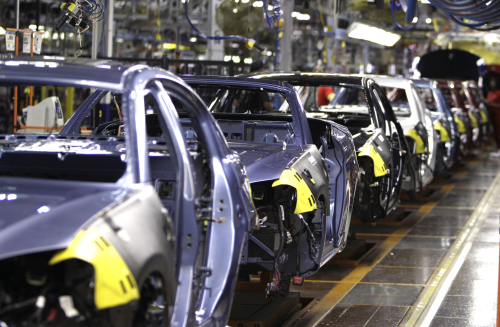White House touts value of emergency loans to GM and Chrysler
WASHINGTON (AP) ― Taxpayers will lose about $14 billion in the government’s $80 billion bailout of Chrysler and GM, the White House said Wednesday, portraying the outcome as good news since the losses are far lower than originally anticipated.
Seizing on the figures, the Obama administration took credit for the resurgence of the U.S. auto industry, assuring taxpayers that the government’s bailout of Chrysler and GM was an investment worth making.
 |
2011 Chrysler vehicles are seen on the assembly line at the Sterling Heights Assembly Plant in Sterling Heights, Michigan. (AP-Yonhap News) |
A report by the president’s National Economic Council noted that as Detroit automakers rebound, the taxpayers’ loss from the bailout will be about $14 billion, or less than 20 percent of the $80 billion that the Bush and Obama administration used to prop up the companies in 2008. The Treasury Department had expected losses closer to 60 percent.
The report was part of a carefully devised strategy by the White House to draw attention to an industry that’s on the mend and whose footprint is most noticeable in key presidential battleground states. In recent days, Vice President Joe Biden and Treasury Secretary Timothy Geithner have both promoted the government’s GM and Chrysler interventions as risky moves by President Barack Obama that paid off.
Obama is making the most out of Chrysler’s announcement last week that it is repaying $5.9 billion in U.S. loans and a $1.7 billion loan from the Canadian government ahead of schedule. Those payments cover most of the federal bailout money that saved the company after it nearly ran out of cash and went through a government-led bankruptcy.
General Motors Co., which also went through bankruptcy, received $49.5 billion in the U.S. bailout. The federal government has lowered its equity stake in the company from 61 percent to 26.5 percent of GM after selling part of the stake in November. Ford did not seek federal government assistance.
The National Economic Council report said that since GM and Chrysler emerged from bankruptcy last year, the industry as a whole has created 115,000 jobs.
The White House is reveling in an “I-told-you-so” moment and Obama himself will take that message Friday to a Chrysler plant in Toledo, Ohio.
Ron Bloom, the president’s top manufacturing adviser, summed up the White House point of view Wednesday: “At the time the president chose to help Chrysler, at the time he chose to help General Motors, a lot of people said you’re throwing good money after bad, you’ll never get out, these companies are not savable.”
The auto industry success is a potentially powerful political story for the president. With Washington focused now on budget cutting, the administration does not have the political leverage to spend money on jobs initiatives, let alone a new economic stimulus.
Still, any claim that the administration can make that it saved or restored jobs is a plus in an environment where unemployment hovers around 9 percent.
What’s more, the auto industry is prominent in states like Michigan, Ohio, Indiana and Missouri, all of them important for Obama’s re-election prospects.
“We believe the steps we took and the steps they took in partnership with us have positioned these companies to where they have a real chance of success,” Bloom said.
Republicans had proposed an alternative that relied on private sector investment. It included government-provided insurance to cover half of investor losses.
“The administration’s auto bailout is nothing to celebrate; there were better options that could have saved jobs for these workers,” Brendan Buck, a spokesman for House Speaker John Boehner, said
Bloom declined to say when the government would sell its remaining stake in GM. The company’s stock price fluctuated between $29 and $39 over the last two months. It was selling at just over $30 per share on Wednesday. “We’re not going sell at a fire sale the first day we can, on the other hand we’re not holding, waiting for a target price,” Bloom said.
The administration’s decision to promote the industry and the role of the bailouts came on the same day the industry reported a falloff in May sales after their aggressive performance earlier this year.
General Motors’ sales fell 1.2 percent as it offered fewer deals to customers and cut sales to rental car companies. Ford sales fell 2.4 percent as strong sales of small cars were weighed down by lower sales of pickup trucks.
The White House economic report sounded one word of warning for Chrysler, saying it continues to face challenges. It cited a product line that still relies heavily on large vehicles and light trucks. The report added: “It must prove its ability to overcome past skepticism about its brand and attract and retain customers over the long term.”
Still, in an opinion piece in Wednesday’s edition of The Washington Post, Geithner said U.S. auto companies are now at the forefront of a comeback in American manufacturing.
“We cannot guarantee their success, and at some point they may stumble. But we’ve given them a better shot,” Geithner wrote. “While we will not get back all of our investments in the industry, we will recover much more than most predicted, and far sooner.”
GM and Chrysler were on the verge of collapse in the final days of the Bush administration after Congress failed to approve an emergency loan package. The Bush administration gave the companies $17.4 billion in loans and required them to develop a restructuring plan by mid-February 2009.








